Tuesday, 13 June 2006
Distance 17 km
Duration 4 hours 10 minutes
Ascent 430 m, descent 297 m
Map 37 of the TOP 100 blue series (now superseded)
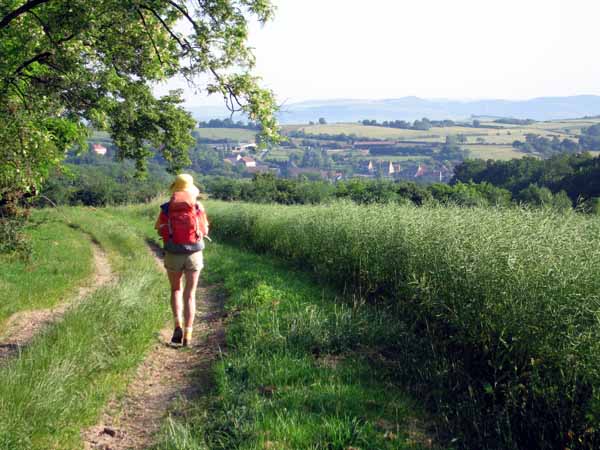
We got up at 6:30 am and left at 7. It has not taken us long to get into a strict pattern of early starts. The alternative is too painful. Our muesli was improved by the rest of the big black luscious stolen cherries from yesterday.
Returning to the village square, we set off on the D124, climbing through vines to St-Mard-de-Vaux, the last of the three towns on the wine circuit of the valley.
We passed perching stone houses, a church and an auberge (now defunct) without seeing a soul and continued up steeply into a forest, feeling somewhat weak in the leg. Walking along the old railway line had made us soft.
At the top, the forest thinned and we took a sharply falling track to la Ferme de la Fôret. At the farmyard, there were new-born yellow ducklings being herded by their mother. A woman came out at the barking of the dog, and assured us that the line on our pathetic scrap of a map was a path that would take us in the right direction.
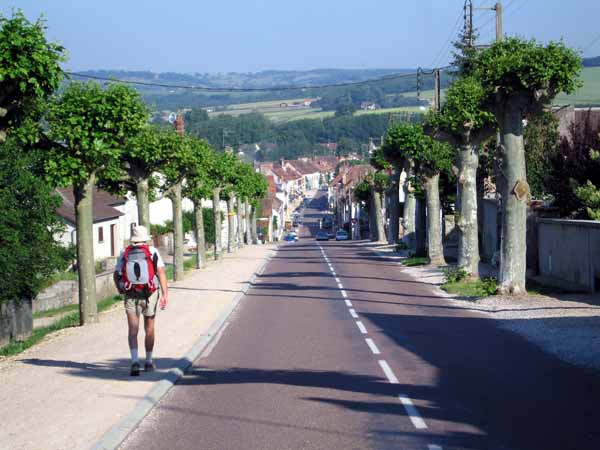
This was good news, as otherwise we would have had to take an enormous detour. The rutted wheel track led down, over the D978 on an iron bridge, and into the outskirts of Charrency, where we turned left and cruised down an avenue of plane trees, brutally lopped, into the town of Saint-Léger-sur-Dheune.
These avenues are typical of provincial France and have a charm that is hard to explain. The trees look like imbeciles, with childish heads on mature bodies. They cast almost no shade this early in the season. The appeal must be in the triumph of man over unruly nature.
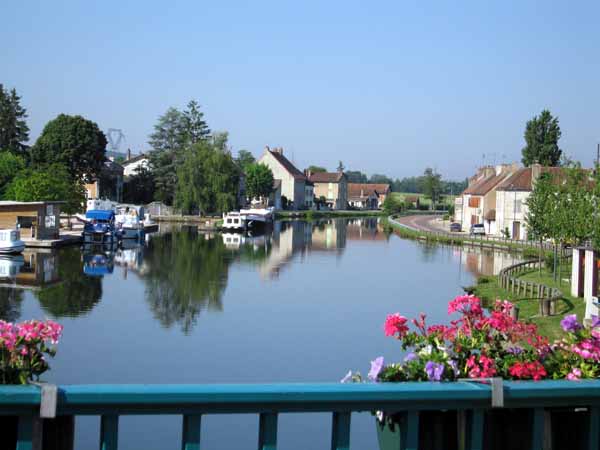
The best part of the town was the bridge over the ample river, hung with baskets of flowers. The local café was only just gearing up, although it was after 11, and we had to sit in a brown, stuffy interior with blaring TV to have coffee.
But the patrone drew back the curtains to let the sun in and we had lovely buttery croissants.
Leaving town, we came across a large supermarket – more prevalent every year on the outskirts of country towns in France – and laid in some lunch supplies – tinned mackerel in lemon, camembert and tomatoes.
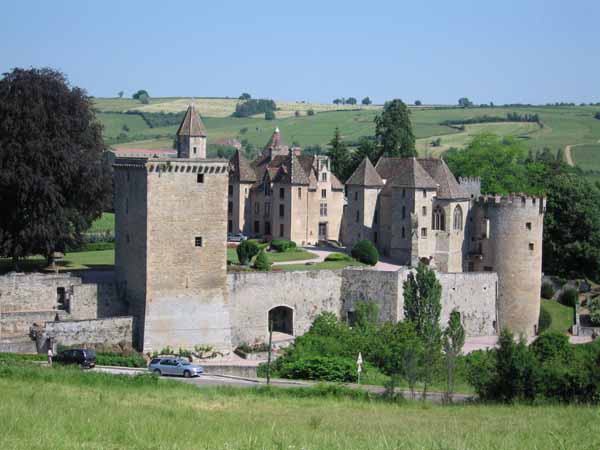
It was getting hot by now, but with the aid of our photocopied TOP 25 map (the very detailed map that we had used two years ago in Burgundy), we were able to take another short cut, which turned out to be a dirt track amongst fields.
This led us over a rise to a sudden view from above of the Château of Couches, a graceful grey pile looking out to a broad valley. I clambered under a fence and took a photo, with an inquisitive horse following me, then we hopped over a ditch and onto the bitumen of the town.
When we got closer we saw that the château was hemmed in by roads, although it still had a dreaming air. It was closed to visitors at the time (not that we would have gone in – we are travellers, not sight-seers).
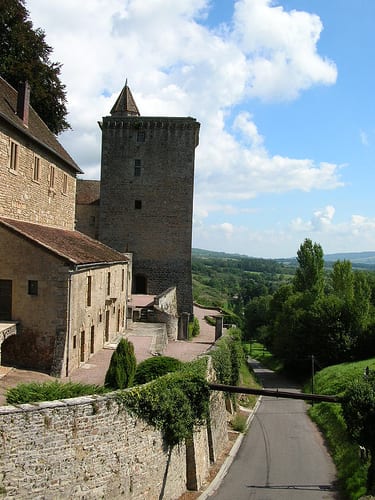
Much is made of the connection between this castle and Marguerite de Bourgogne. While she seems to have spent some of her childhood there, it is an altogether darker connection that catches our interest.
She was the daughter of a powerful Burgundian lord and the grand-daughter (through her mother) of Louis IX, the saint-king. At 15, in the year 1305, she was married to the heir to the French throne, the future Louis X. Nine years later she was denounced, with one of her sisters-in-law, for adultery with a pair of dashing brothers at the court.
Seemingly the charms of these brothers were greater than those of their royal husbands, but they paid for this with every possible grisly torture before being executed. The girls were imprisoned while their husbands decided what to do with them.
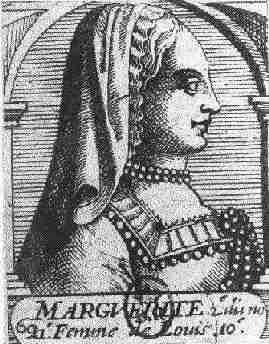
Marguerite was in the dungeon of the Chateau Gaillac, not far from Giverny. Within a few months the old king died, leaving her suddenly the queen of France, a deeply embarrassing state of affairs. Louis’ efforts to have the marriage annulled by the pope were impeded when the latter also died, but the situation was resolved by an announcement the following year that Marguerite herself had died – death upon death upon death.
There are two versions of what actually happened at this point. One is that the young queen was strangled (with her own hair), or succumbed to cold and starvation in her cell. The other is that a deal was done with her powerful family and she was hurried away by night to the Chateau of Couches, far from the capital, to live another 18 years in great secrecy. This is the version, naturally, that the locals prefer.
A long built-up road-bash took us into the centre, which is small but elegant, with several grand residences from former times. Like many small French towns, they were spending money on improving their appeal to the tourist – paving the footpaths, suspending baskets of flowers from street lights, etc.
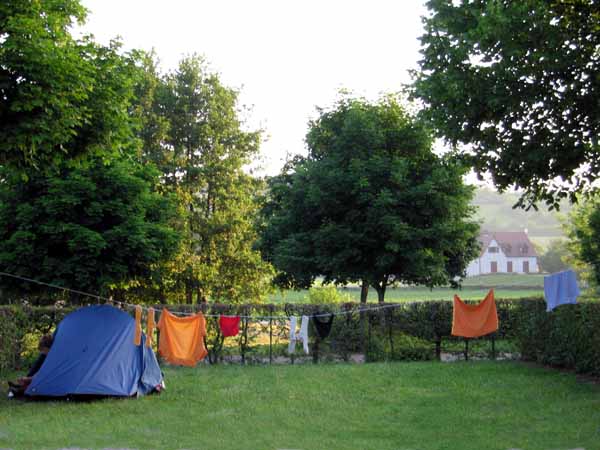
In the Place de la Mairie we found an auberge with tables set under a long awning. Although it was close to lunch time, they gave us coffee at one of the unlaid tables, with a preliminary jug of cold water.
All this was very pleasant, until we stepped across the square to enquire at the Syndicat d’Initiative about the camping.
The news was that it was three or four kilometres out of town. It was not so much the distance that bothered us, it was the heat of the day, but when we looked at the town map we realised that the distance was nothing like as far as the girl had said. Nevertheless we suffered in the scorching sun as we trudged along.
The camping was a spacious municipal ground, terraced up the slope, not particularly crowded, with a café attached.
We had lunch and a siesta, then a shower – unfortunately the showers were not delivering water that day.
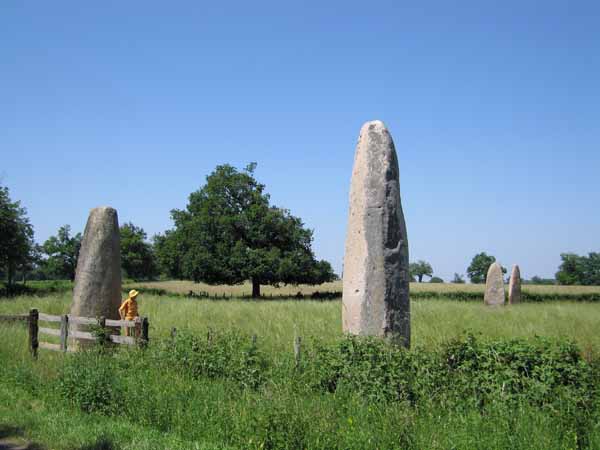
The water pipe had been dug up by mistake. But we were allowed to have our showers in a private bathroom attached to the café, so we were happy. The cost was €6.35, a good price for a place with all the comforts.
I asked about visiting the nearby Menhirs d’Epoigny, and an old fellow at the bar told us about a pedestrian short-cut that we could take, starting from the Rue de la Perce, just before the turn-off to the camping, and joining a bitumen road on the ridge.
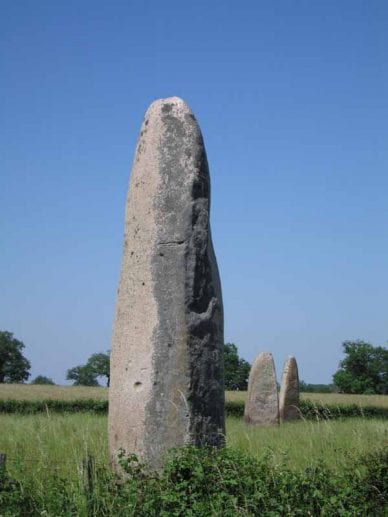
Feeling fresh without our packs and boots, we set off, despite the scorching heat, on what we expected to be a short stroll, only to find ourselves on a waterless two-hour trek, at the end of which Keith had developed a very painful knee. This affliction persisted for a couple of weeks.
Once we got to them, the menhirs were wonderfully impressive. A normal grassy field contained these monstrous incongruous standing stones, silent and puzzling. It looked as if the farmer had somehow failed to notice them.
Nobody seems to know much about these stones, which occur all over Europe, and date from at least 4000 years ago, perhaps as much as 7000.
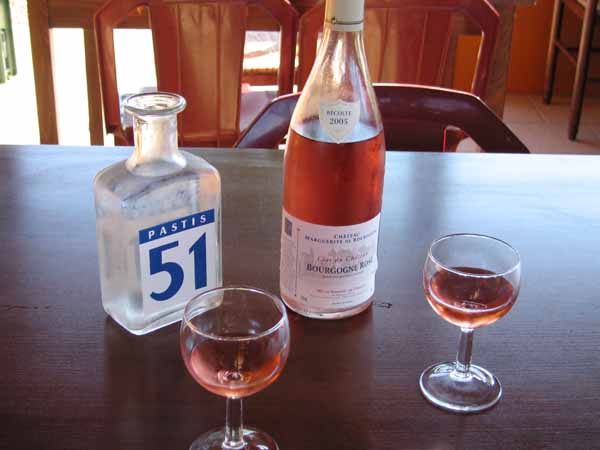
The amount of effort required to carve and position them must surely mean that they were of great ritual significance, unlike many of the cave paintings from the same period, which could well have been done for enjoyment only. (Indeed it seems that a lot of the “fertility symbols” in caves may have been done by adolescent boys, for reasons familiar to modern man).
We ate our evening meal at the cafe in the camping ground, as it was too far to trudge back into town.
We had an excellent omelette and an entrecôte, with a bottle of rosé from Marguerite’s chateau.
Previous day: St-Boil to St-Jean-de-Vaux